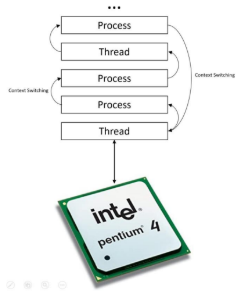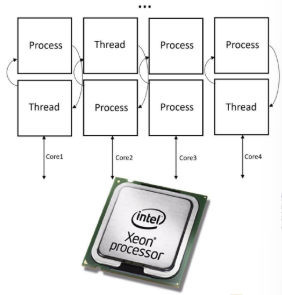processes
1/36
Earn XP
Description and Tags
blue: user-space solution; red: kernel solution
Name | Mastery | Learn | Test | Matching | Spaced |
|---|
No study sessions yet.
37 Terms
virtual processors
built in software, on top of physical processors
processor
provide set of instructions along with the capability of automatically executing a series of those instruction
thread
minimal software processor; lightweight unit of execution within a process performing a task
process
software processor; one or more threads can be executed; heavier, independent units of execution that require more overhead for creation, switching, and destruction.
memory and resources
when a process starts, _ are allocated which are shared by each thread.
single-threaded process
one task at a time

multi-threaded process
many task at the same time

contexts
allow pausing and resuming without losing data
processor context
the minimal collection of values stored in the registers of a processor used for the execution of a series of instructions (e.g., stack pointer, addressing registers, program counter).
thread context
the minimal collection of values stored in registers and memory, used for the execution of a series of instructions (i.e., processor context, thread state – running/waiting/suspended).
process context
the minimal collection of values stored in registers and memory, used for the execution of a thread (i.e., thread context, but now also at least memory management information such as Memory Management Unit (MMU) register values).
independent
threads share the same address space; context switching can be done entirely _ of the operating system.
expensive
process switching is generally (somewhat) more _ as it involves getting the OS in the loop, i.e., trapping to the kernel.
cheaper
creating and destroying threads is much _ than doing so for processes.
avoid needless blocking
a single-threaded process will _ when doing I/O; in a multi-threaded process, the operating system can switch the CPU to another thread in that process.
exploit parallelism
the threads in a multi-threaded process can be scheduled to run in _ on a multiprocessor or multicore processor.
avoid process switching
structure large applications not as a collection of processes, but through multiple threads.
process switching tradeoff
threads use the same address space: more prone to errors; no support from OS/HW to protect threads using each other’s memory; thread context switching may be faster than process context.
user-space solution
threads are managed by a library/user-level package than the kernel
kernel solution
to have the kernel contain the implementation of a thread package; all operations return as system calls.
single process
all operations can be completely handled within a _ ⇒ Implementations can be extremely efficient.
resides
all services provided by the kernel are done on behalf of the process in which a thread _ ⇒ if the kernel decides to block a thread, the entire process will be blocked.
per-event basis
threads are used when there are lots of external events: threads block on a _ ⇒ if the kernel can’t distinguish threads, how can it support signaling events to them?
schedules
operations that block a thread are no longer a problem: the kernel _ another available thread within the same process.
catches
handling external events is simple: the kernel (which _ all events) schedules thethread associated with the event.
loss of efficiency
the problem is (or used to be) the _ due to the fact that each thread operation requires a trap (system call that causes the CPU to switch from user mode to kernel mode) to the kernel.
lightweight processes
can execute user-level threads
fetched
in a multithreaded web client, web browser scans an incoming HTML page and finds that more files need to be _
separate
in a multithreaded web client, each file is fetched by a _ thread, each doing a (blocking) HTTP request; then as files come in, the browser displays them.
linear speed-up
in multiple request-response calls to other machines (RPC), client does several calls at the same time, each one by a different thread then it waits until all results have been returned. if calls are to different servers, we may have a _
multiprocessor system
in improving performance in threads at a server side, having a single-threaded server prohibits simple scale-up to a _.
hide network latency
in improving performance in threads at a client side, _ by reacting to the next request while the previous one is being replied.
blocking calls
in better structure in threads at a server side, most servers have high I/O demands. Using simple, well-understood _ simplifies the overall structure.
flow of control
in better structure in threads at a server side, multithreaded programs tend to be smaller and easier to understand due to simplified _.
multithreading (model)
parallelism, blocking system calls
single-threaded process (model)
no parallelism, blocking system calls
finite-state machine (model)
parallelism, nonblocking system calls